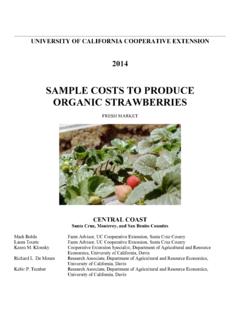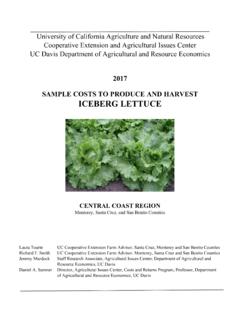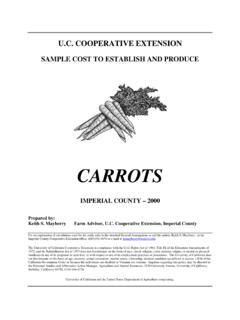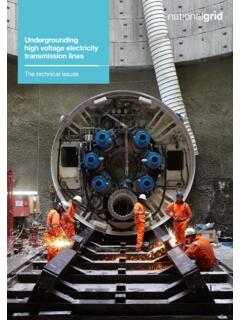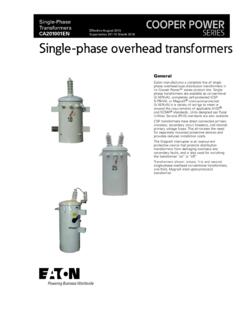Transcription of SAMPLE COSTS FOR BEEF CATTLE
1 BF-SV-08-R. UNIVERSITY OF CALIFORNIA COOPERATIVE EXTENSION. 2008. SAMPLE COSTS FOR BEEF CATTLE . COW CALF PRODUCTION. 300 Head SACRAMENTO VALLEY. Larry C. Forero UC Cooperative Extension Farm Advisor, Shasta County Glenn A. Nader UC Cooperative Extension Farm Advisor, Sutter /Yuba/Butte Counties Karen M. Klonsky UC Cooperative Extension Specialist, Department of Agricultural and Resource Economics, UC Davis Richard L. De Moura Staff Research Associate, Department of Agricultural and Resource Economics, UC Davis UC COOPERATIVE EXTENSION. SAMPLE COSTS FOR BEEF CATTLE COW-CALF PRODUCTION. 300 Cow Head Sacramento Valley 2008. STUDY CONTENTS. 3. Production Operating COSTS .. 3. Cash overhead .. 5. Non-Cash 6. REFERENCES .. 7. Table 1. COSTS and Returns for Beef Cow-Calf 8.
2 Table 2. Monthly COSTS for Beef Cow-Calf Production .. 9. Table 3. Ranging Analysis Returns for Beef Cow-Calf 10. Table 4. Equipment, Investment, and Business 11. INTRODUCTION. The CATTLE industry in California has undergone dramatic changes in the last few decades. Ranchers have experienced increasing COSTS of production with a lack of corresponding increase in income. Issues such as international competition, new regulatory requirements, changing consumer demand, economies of scale, and competing land uses all affect the economics of ranching. Rangeland makes up the largest percentage of acreage in the state. CATTLE operations play an important part on California's environment and landscape. They need to be economically viable to maintain the current landscape.
3 SAMPLE COSTS to raise beef CATTLE are presented in this study. This study is intended as a guide only, and can be used to make production decisions, determine potential returns, prepare budgets and evaluate production loans. Practices described are based on production practices considered typical for a beef CATTLE cow-calf operation, but will not apply to every situation. SAMPLE COSTS for labor, materials, equipment and custom services are based on current figures. The hypothetical CATTLE operation, production practices, overhead , and calculations are described under the assumptions. For additional information or an explanation of the calculations used in the study call the Department of Agricultural and Resource Economics, University of California, Davis, (530) 752-3589 or your local UC Cooperative Extension office.
4 SAMPLE cost of Production Studies for many commodities can be downloaded at , requested through the Department of Agricultural and Resource Economics, UC Davis, (530) 752-4424 or obtained from the local county UC Cooperative Extension offices. Some archived studies are also available on the website. The University of California does not discriminate in any of its policies, procedures or practices. The university is an affirmative action/equal opportunity employer. 2008 Beef CATTLE COSTS and Returns Study Sacramento Valley UC Cooperative Extension 2. ASSUMPTIONS. The assumptions refer to Tables 1 to 4 and pertain to SAMPLE COSTS to operate a beef cow calf operation. Practices described represent production practices and materials considered typical of a well-managed ranch in the region.
5 The COSTS , materials, and practices shown in this study will not apply to all situations. Production practices vary by rancher and the differences can be significant. The study does not represent a single ranch and is intended as a guide only. The use of trade names and ranching practices in this report does not constitute an endorsement or recommendation by the University of California nor is any criticism implied by omission of other similar products or cultural practices. Farm. The CATTLE producer rents all range and pasture land. The farm is a typical owner-operated cow-calf ranch operation in the northern Sacramento Valley. Grazing requires 6 to 17 acres per cow-calf pair, depending upon the amount of forage available. Actual herd numbers in California vary widely, ranging from part-time operations of less than 10 cows to operations running thousands.
6 This cost study is based upon numbers from a herd of 300 cows. Ranching operations in California can be generally classified into four types. The first type includes part-time operations that run a small number of animals (less than 20) in order to utilize existing forage resources, keep the grass down, or on a hobby-type basis. The second type includes medium-sized operations (around 75 cows). that are run as a separate business, but are part of a larger diversified operation with farming or other businesses. The third type includes large operations (over 200 cows) where CATTLE production is the primary enterprise and source of income. The final category includes large CATTLE ranches that are supported by supplemental income from other farm and non-farm sources.
7 The cost calculations are based on economic principles that include all cash COSTS . This analysis has used a rental value of the AUMs as a cost of operation. For this reason land taxes, fence and building depreciation, and land value are not considered in the COSTS . Production Operating COSTS Pasture, Hay and Supplements. This includes the market value of all feed (purchased or raised) that was used in the cow-calf operation. Mineral supplements and salt are provided to the animals year round. Livestock are fed stock quality alfalfa hay only over short periods of time when there is limited feed available on rangeland and during weaning and shipping. Each animal consumes approximate one-half ton of hay. Winter range feeding is from November through April, and summer feeding on irrigated or mountain pasture from May through October.
8 Health, Veterinary, Medicine. This includes the value of vaccines, medicines, veterinary services, fertility testing, breeding fees, etc. Prebreeding vaccinations are done in December, dry cow vaccinations and deworming in August. Steer and heifer calves are branded, dehorned, and vaccinated in March. The bull calves are also castrated in March. Heifer calves booster vaccinations are given in May. In this study, it is assumed three-fourths of the COSTS occur in May and one-fourth equally split between August and November. Many of the ranchers participating in the budget review no longer invest in pregnancy testing of their cows in an effort to reduce veterinary COSTS to the operation. Horse Maintenance. COSTS for shoeing horses, veterinary and feed expenses are based on COSTS reported by the participating producers.
9 2008 Beef CATTLE COSTS and Returns Study Sacramento Valley UC Cooperative Extension 3. Vehicle/Freight. Pickup business vehicle mileage is estimated at 15,000 miles per year and includes mileage while pulling the stock trailer. Estimated mileage for the stock trailer is 2,300 miles and the All Terrain Vehicle (ATV) 4-wheeler is 3,500 miles per year. Prices for on road use of diesel is $ per gallon and $ for gasoline. The COSTS are based on November 2007 to April 2008 American Automobile Association (AAA) and Department of Energy monthly fuel price data. Freight or trucking COSTS are commercial COSTS for hauling the CATTLE between summer and winter grazing. Each load can haul approximately 50,000 pounds (approximately 35 mature cows). Repairs Vehicle/Equipment. Repairs for vehicles are calculated as 7% of the purchase price and equipment as 2%.
10 Labor Most ranchers can no longer afford hired labor, but may use volunteer weekend help. Owner labor for hauling turnout, gathering, feeding, fence repair, irrigation, salting, checking cows, and moving pastures is also not included as a cost . Based upon general producer information, the estimated owner man-hours are hours per cow per year and the estimated weekend volunteer labor is hours per cow per year. Operations and Marketing. The Operations Table A. Operations Calendar Calendar for a beef breeding herd selling weaned Month Operation calves is shown in Table A. Operations will vary September 1 to December 1 Calving according to the season. November 1 to April 30 Winter Range December 1 to February 28 Breeding Marketing. Marketing is based on range and May 1 to October 31 Irrigated Pasture pasture operations for a 300 cow herd with a 89% March Cull Cows Sold calf crop born, 85% of the calf crop (cows March Cull Bulls Sold exposed to bulls) weaned, 1% cow mortality, and May Calves Sold 11% (9% cull and 2% death) herd replacement.

